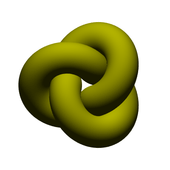Ropelength
In physical knot theory, each realization of a link or knot has an associated ropelength. Intuitively this is the minimal length of an ideally flexible rope that is needed to tie a given link, or knot. Knots and links that minimize ropelength are called ideal knots and ideal links respectively.

Definition
The ropelength of a knot curve C is defined as the ratio , where Len(C) is the length of C and τ(C) is the thickness of the link defined by C.
Ropelength minimizers
One of the earliest knot theory questions was posed in the following terms:
Can I tie a knot on a foot-long rope that is one inch thick?
In our terms we are asking if there is a knot with ropelength 12. This question has been answered, and it was shown to be impossible: an argument using quadrisecants shows that the ropelength of any nontrivial knot has to be at least 15.66.[1] However, the search for the answer has spurred a lot of research on both theoretical and computational ground. It has been shown that for each link type there is a ropelength minimizer although it is only of class C 1, 1.[2][3] For the simplest nontrivial knot, the trefoil knot, computer simulations have shown that its minimum ropelength is at most 16.372.[1]
Dependence of ropelength on other knot invariants
An extensive search has been devoted to showing relations between ropelength and other knot invariants. As an example there are well known bounds on the asymptotic dependence of ropelength on the crossing number of a knot. It has been shown that
and
for a knot C with crossing number Cr(C) and ropelength L(C), where the O and Ω are examples of big O notation and big Omega notation, respectively.
The lower bound (big Omega) is shown with two families ((k, k−1) torus knots and k-Hopf links) that realize this bound. A former upper bound of O(Cr(C))3/2 has been shown using Hamiltonian cycles in graphs embedded in a cubic integer lattice.[4] The current best near-linear upper bound was established with a divide-and-conquer argument to show that minimum projections of knots can be embedded as planar graphs in the cubic lattice.[5] However, no one has yet observed a knot family with super-linear length dependence L(C) > O(Cr(CK)) and it is conjectured that the upper bound is in fact linear.[6]
Ropelength as a knot invariant
Ropelength can be turned into a knot invariant by defining the ropelength of a knot type to be the minimum ropelength over all realizations of that knot type. So far this invariant is impractical as we have not determined that minimum for the majority of knots.
References
- Denne, Elizabeth; Diao, Yuanan; Sullivan, John M. (2006), "Quadrisecants give new lower bounds for the ropelength of a knot", Geometry & Topology, 10: 1–26, arXiv:math/0408026, doi:10.2140/gt.2006.10.1, MR 2207788.
- Gonzalez, O.; Maddocks, J. H.; Schuricht, F.; von der Mosel, H. (2002), "Global curvature and self-contact of nonlinearly elastic curves and rods", Calculus of Variations and Partial Differential Equations, 14 (1): 29–68, doi:10.1007/s005260100089, MR 1883599
- Cantarella, Jason; Kusner, Robert B.; Sullivan, John M. (2002), "On the minimum ropelength of knots and links" (PDF), Inventiones Mathematicae, 150 (2): 257–286, arXiv:math/0103224, Bibcode:2002InMat.150..257C, doi:10.1007/s00222-002-0234-y, MR 1933586.
- Diao, Yuanan; Ernst, Claus; Yu, Xingxing (2004), "Hamiltonian knot projections and lengths of thick knots" (PDF), Topology and its Applications, 136 (1–3): 7–36, doi:10.1016/S0166-8641(03)00182-2, MR 2023409.
- Diao, Yuanan; Ernst, Claus; Por, Attila; Ziegler, Uta (2009), The Ropelengths of Knots Are Almost Linear in Terms of Their Crossing Numbers, arXiv:0912.3282, Bibcode:2009arXiv0912.3282D.
- Diao, Yuanan; Ernst, Claus (2004), "Realizable powers of ropelengths by non-trivial knot families" (PDF), JP Journal of Geometry and Topology, 4 (2): 197–208, MR 2105812, archived from the original (PDF) on 2005-02-15.